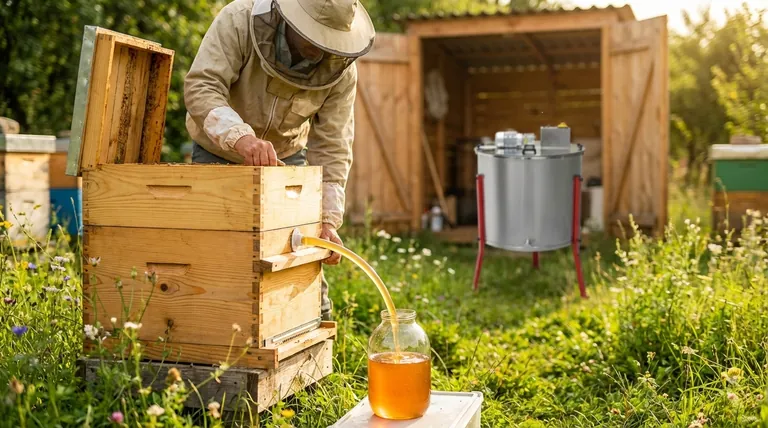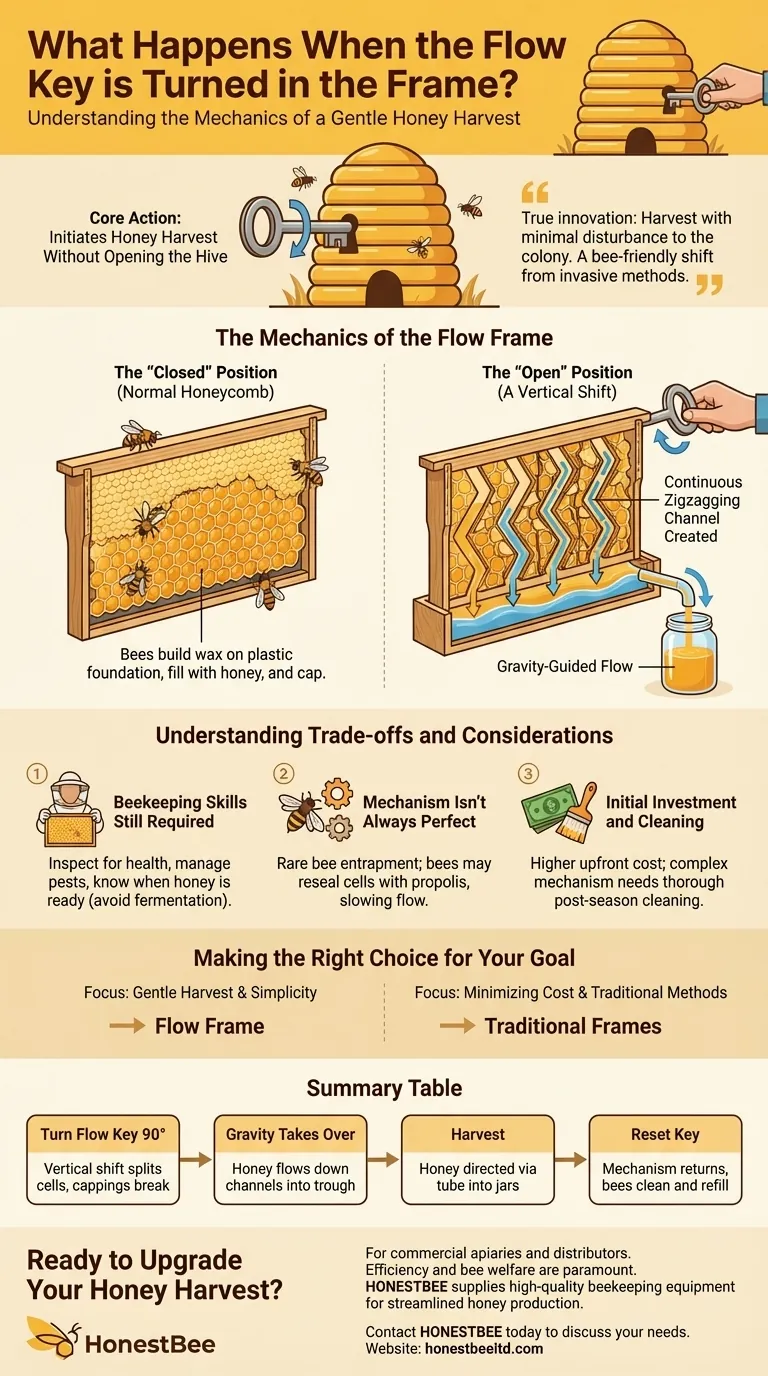At its core, turning the Flow Key is the action that initiates a honey harvest without opening the hive. This movement triggers a mechanical shift within the specially designed Flow Frame, vertically splitting the honeycomb cells. This creates a direct channel for the honey to flow downwards, guided by gravity, into a sealed trough and out of an exit port, much like turning on a tap.
The true innovation isn't just the flow of honey, but the ability to harvest it with minimal disturbance to the colony. Understanding this mechanism reveals a fundamental shift from traditional, invasive extraction methods to a more integrated and bee-friendly process.

The Mechanics of the Flow Frame
To grasp the full picture, it’s helpful to visualize the frame in its two states: the normal "cell" state for the bees, and the "channel" state for the harvest.
The 'Closed' Position: A Normal Honeycomb
Before you intervene, the Flow Frame provides a partially formed plastic honeycomb foundation. The bees complete this structure with their own wax, creating standard hexagonal cells. They then fill these cells with honey and cap them with wax, just as they would in any traditional frame.
The 'Open' Position: A Vertical Shift
The Flow Key is essentially a long lever that engages with a mechanism at the top of the frame. When you turn it 90 degrees, it forces one side of the plastic cell foundation to shift vertically relative to the other.
This shearing action breaks the wax cappings and splits each cell in half. The offset halves no longer form a sealed container but instead create a continuous, zigzagging channel running from the top of the frame to the bottom.
The Path of the Honey
Once the channels are open, gravity takes over. The honey, now freed from the confines of the cells, flows down these newly formed pathways. It collects in a sealed trough built into the bottom of the frame, which directs it out of the hive through a tube, ready for collection. After the harvest, turning the key back resets the cells, allowing the bees to repair the cappings and start refilling them.
Understanding the Trade-offs and Considerations
While the mechanism is ingenious, an objective assessment requires looking at the practical implications. This is not a "set and forget" system.
You Still Need Beekeeping Skills
The Flow system simplifies the harvest, not the entirety of beekeeping. You must still inspect the hive for health, manage pests like Varroa mites, and, critically, know when the honey is ready. Harvesting uncured nectar (honey with high water content) will result in fermented, spoiled honey, regardless of the extraction method.
The Mechanism Isn't Always Perfect
In some instances, bees can be caught in the moving parts of the cell mechanism, though this is relatively rare. More commonly, bees may begin to reseal the cells with propolis or wax as the honey is draining, which can slow or stop the flow. This often requires patience and sometimes a second turn of the key to clear the channels.
Initial Investment and Cleaning
Flow Frames represent a significantly higher upfront cost compared to traditional wooden frames and wax foundation. Furthermore, the complex plastic mechanism requires thorough cleaning after the season to prevent crystallization and ensure smooth operation for the following year.
Making the Right Choice for Your Goal
The decision to use a Flow system depends entirely on what you want to optimize for in your beekeeping journey.
- If your primary focus is a gentle harvest and simplicity: The Flow Frame's mechanism is designed precisely for you, as it dramatically reduces colony stress and eliminates the need for a separate extractor.
- If your primary focus is minimizing cost and embracing traditional methods: The expense and mechanical nature of Flow Frames may be less appealing than classic wooden frames and a club-owned extractor.
Ultimately, understanding how the Flow Key works empowers you to see past the marketing and evaluate the tool based on its mechanical merits and how they align with your beekeeping philosophy.
Summary Table:
| Action | Mechanism | Result |
|---|---|---|
| Turn the Flow Key 90° | A vertical shift splits the honeycomb cells. | Wax cappings break, creating channels. |
| Gravity Takes Over | Honey flows down the newly formed channels. | Honey collects in a sealed trough. |
| Harvest | Honey is directed out of the hive via a tube. | Pure honey is collected directly into jars. |
| Reset the Key | The mechanism returns the cells to their original position. | Bees can clean and refill the comb. |
Ready to Upgrade Your Honey Harvest?
For commercial apiaries and distributors, efficiency and bee welfare are paramount. The gentle, on-tap harvest of a Flow Hive system can revolutionize your operation.
HONESTBEE supplies the high-quality beekeeping equipment you need to succeed. We provide durable, reliable supplies through our wholesale-focused operations, helping you manage your hives more effectively and humanely.
Contact HONESTBEE today to discuss how our equipment can streamline your honey production and benefit your bees.
Visual Guide

Related Products
- 24 Frame Honey Extractor Commercial Radial Honey Frame Extraction Machine
- electric honey extractor honey centrifuge 3 frame honey extractor stainless steel honey frame extractor
- HONESTBEE 3-Frame Manual Acrylic Honey Extractor
- 6 Frame Manual Stainless Steel Honey Extractor Beekeeping Equipment
- HONESTBEE 72 Frame Industrial Electric Honey Extractor for Beekeeping
People Also Ask
- What are the advantages of a stainless steel honey extractor? Ensure Honey Purity & Long-Term Value
- Which type of extractor is better for medium to large-scale honey processing? Boost Efficiency with Electric Radial Extractors
- How should the extractor be cleaned after use? Protect Your Honey & Equipment Investment
- What type of honey extractor is best? Maximize Your Harvest Efficiency with the Right Choice
- Can honey extractors accommodate different frame sizes? A Guide to Choosing the Right Extractor



















